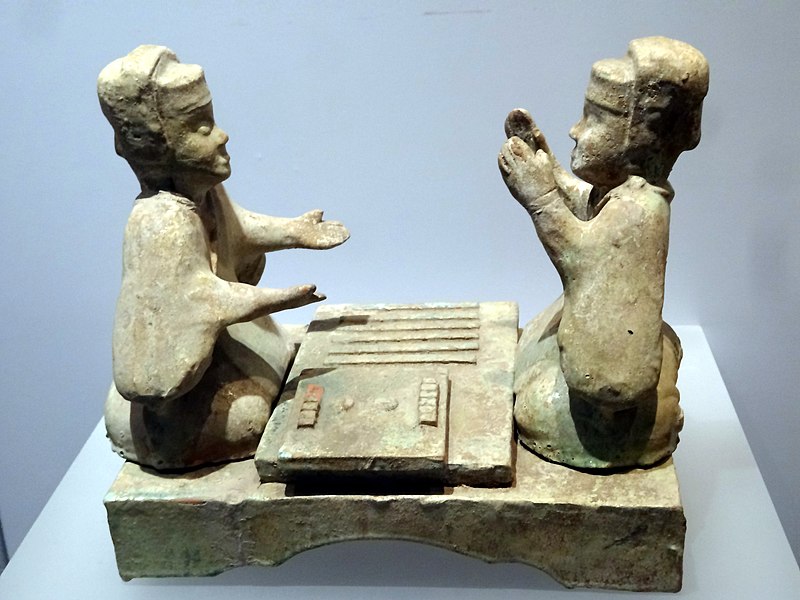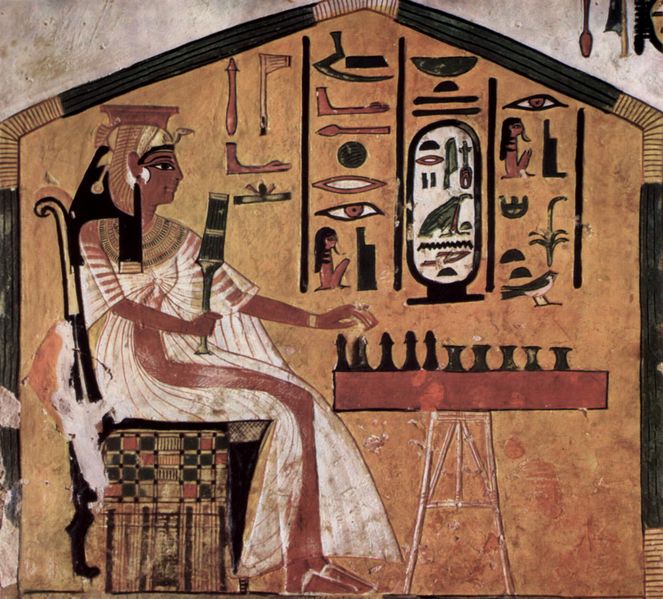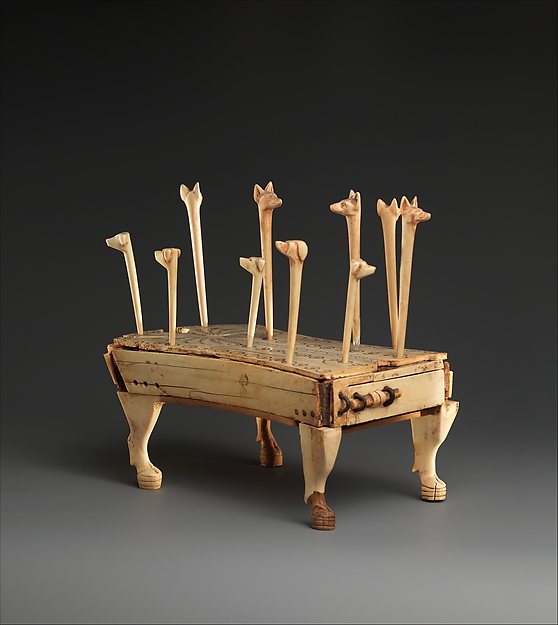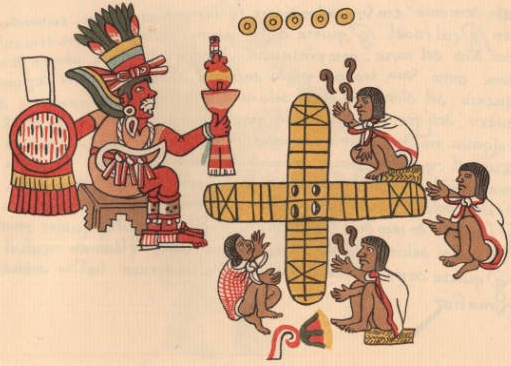BY: CHRISTOPHER WAI
 |
| "Green-glazed pottery figurines representing Liubo players" unearthed in tomb at Lingbao, Henan Museum, China. Sources: 1 , 2 |
"Hence some friends drink or dice together, [...] for wishing to live in their friends’ society, they pursue and take part with them in these occupations as best they can."
-Aristotle, Nicomachaean Ethics. 9.12
“...Are there not gamesters and chess players? To be one of these would still be better than doing nothing at all.”
-The Analects of Confucius
It seems so mundane at one level, away from the grand spectacles of say, gladiator battles, ritual ball games, ceremonial feasts, chariot races, festivals, theatrics, dance or music. And yet, if you'll indulge me, it seems on some level so much more intimate.
Imagine just a few players, probably friends, maybe some onlookers and a few conversations be they light, serious or raucous- little things that don't get recorded in great detail in monuments and texts. "It's the little things in life", as the saying goes. The game may even hold subtleties about the world they lived in, be they social, political or ritual.
 |
| "Wall-painting of game-players from a bar on the Via di Mercurio", Pompeii. Source |
 | ||||
| Mural of Liubo players from an Eastern Han Tomb, Henan Province, China. Source |
Of course, I don't want to read too much into it and make grand assumptions about daily life or cast it as the de-facto representation of daily pastimes for all classes, cultures, times or places. Some games may have held far more ritual and/ or symbolic meaning than that which we can imagine in our present day for example.
But there are surviving boards, game pieces and scenes depicted here and there, and the hints of the stories behind them.
But there are surviving boards, game pieces and scenes depicted here and there, and the hints of the stories behind them.
Here
are an idiosyncratic collection of games of from across the world.
Individually, there isn't always much known, but collectively, it's a
little more than I had anticipated when I started. I suppose that only
shows how such games have had some presence in many cultures in one form
or another.
Feel free to skim or look in detail, you'll no doubt find something of interest!
Feel free to skim or look in detail, you'll no doubt find something of interest!
In China cultured men and women were expected to master the Four Arts – four cultural pursuits that took years to perfect: playing the qin (zither)...playing weiqi (a type of chess)...writing fine Chinese calligraphy... making, appreciating and critiquing classical Chinese painting.- British Museum
 |
| Silk painting of a woman playing weiqi (Go), from the Astana Graves, Tang Dynasty. Xinjiang Uighur Autonomous Region Museum . Source |
"Polybius relates with regret what occurred at the capture of the city, and speaks of the indifference the soldiers showed for works of art, and the sacred offerings of the temples. He says, that he was present, and saw pictures thrown upon the ground, and soldiers playing at dice upon them." -Strabo, Geography. 8.6.
 |
| "Achilles and Ajax playing a board game. Attic black-figure amphora, ca. 500 BC", Staatliche Antikensammlugen Museum, Munich. Source |
"Lay not my bones apart from thine, Achilles, but let them lie together, even as we were reared in your house, when Menoetius brought me, being yet a little lad, from Opoeis to your country, by reason of grievous man-slaying, on the day when I slew Amphidamus' son in my folly, though I willed it not, in wrath over the dice." - Homer, The Iliad 23.85
 |
| Painting of Queen Nerfertari playing a game of Senet from her Tomb, New Kingdom, Egypt Source. Additional: Facsimile |
“Formulae for elevation and transfiguration, for going out from the necropolis, for being in the following of Osiris, and being content with the food of Wennefer, going out by day, taking any form desired to be taken, playing the board-game senet, being in the pavilion, a living soul, the Osiris N among the revered before the great Ennead which is in the west, after he moors. This is good for the one who does it on earth. The words come to pass, in completion. Words spoken by the Osiris N:”
-Egyptian Book of the Dead, Chapter 17
 |
| Tutankhamun's "travelling" Senet set. Source: BBC |
 |
| Hounds and Jackals game set, found by Howard Carter and Lord Carnarvon in 1910. Middle Kingdom, Egypt. Metropolitan Museum of Art |
"Egyptians likened the intricate voyage through the underworld to a game. This made gaming boards and gaming pieces appropriate objects to deposit in tombs."
- Metropolitan Museum of Art
 |
| Game board for playing Mehen (name of Egyptian Snake God), Early Dynastic Egypt. Game pieces were shaped like lions and marbles. British Museum. |
 |
| The Mesoamerican game of Patolli overseen by the god Macuilxochitl, Aztec Codex Magliabecchiano. Source |
 |
| The Royal Game of Ur. 2500 BC-2400 BC. Royal Cemetery of Ur, Mesopotamia. British Museum. |
"The board lay face upwards in the soil [...] when the presence of the object was recognized we worked along it a square or so at a time, pouring hot wax over it as we went, and finally the whole was secured with waxed cloth and lifted..."
-Leonard Woolley on the discovery of the Royal Game of Ur
 |
| Board Game, Indus Valley Civilization (3500-1700 BCE). Source |
 |
| Maze and Dice, Indus Valley Civilization (3500-1700 BCE).Source |
Conclusion
One of my grade school teachers, thinking that it was Ancient Egyptian, once tried to engage us with ancient history through a game called Alquerque using penciled in sheets of paper and a pile of black and white beans. I'm not sure how effective it was, but here I am still thinking about it.
These game boards and pieces seem to challenge anyone trying to learn more about them to actually engage with them by default.
These game boards and pieces seem to challenge anyone trying to learn more about them to actually engage with them by default.
One can hardly just stare at them and read about the rules or talk about them in a vacuum anymore than one can just hear of chess or poker as a novice and be an expert. We can certainly analyze the possible symbolism, source the raw material(s), the processes involved in their manufacture, and their distribution, but it is a game after all. It's designed to be played and when it was played, there was a social element that was once there.
 |
| Left to right: Shogi, Go, Ban-Sugoroku games, Japan. ca. 1780. Source |
More Info:
Article on Knucklebones:
http://archaeologicalmuseum.jhu.edu/the-collection/object-stories/archaeology-of-daily-life/childhood/knucklebones
Fantastic collection of images of depictions of the Chinese Liubo game in the English language:


No comments:
Post a Comment
Note: only a member of this blog may post a comment.